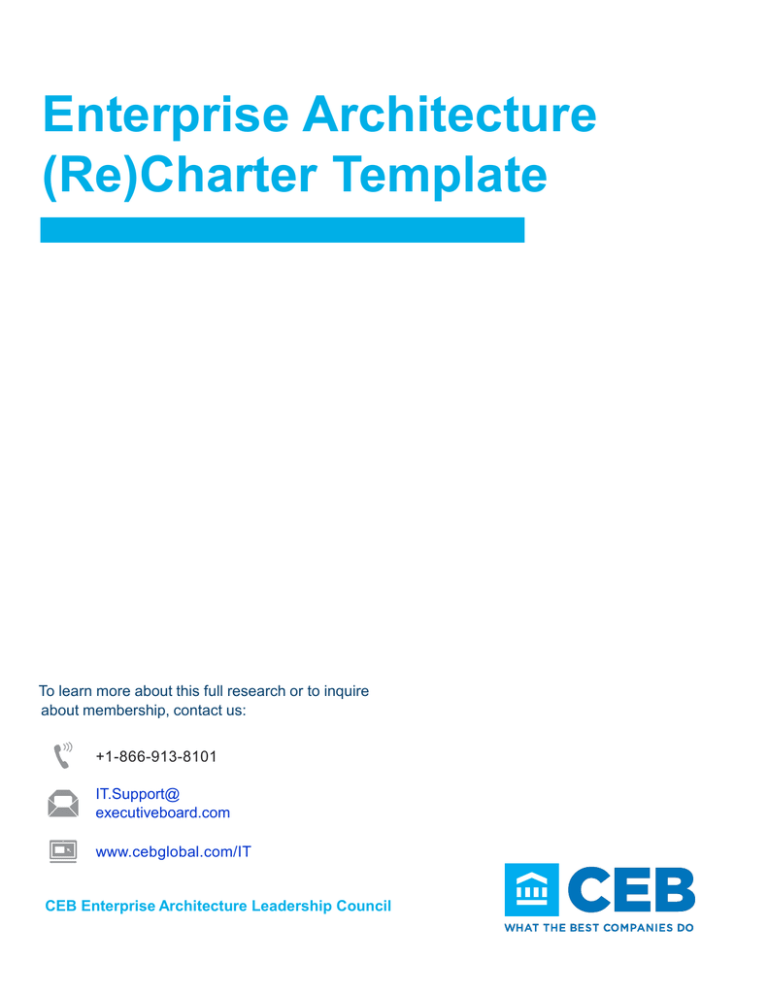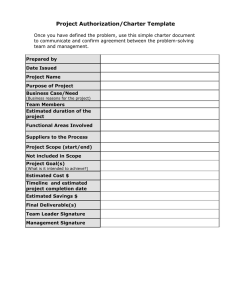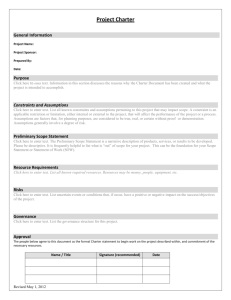
Enterprise Architecture
(Re)Charter Template
To learn more about this full research or to inquire
about membership, contact us:
+1-866-913-8101
IT.Support@
executiveboard.com
www.cebglobal.com/IT
CEB Enterprise Architecture Leadership Council
Enterprise Architecture (EA) Program Charter Template
Enterprise Architecture (EA) Program
(Re)Charter Template
CEB Enterprise Architecture Leadership Council
This template is intended to fast-cycle the (re)chartering of an EA group. Because this template is designed to
identify progressive EA group priorities, it largely focuses on the changes that need to take place in the EA
operating model. Based on member feedback about EA functional performance and priorities, we’ve designed this
charter template so that it can be used by EA groups that are being initialized, as well as groups that are being
reformed or “rechartered”. Supporting foundational sections are included as appendices.
For further implementation support, see CEB’s Enterprise Architecture Leadership Council website and the study
Rechartering EA: A New Operating Model for Actionable Strategy and Scalable Project Engagement.
© CEB 2013
1
Enterprise Architecture (EA) Program Charter Template
Table of Contents
Document Purpose ......................................................................................................................... 3
Background ..................................................................................................................................... 3
1: Introduction ................................................................................................................................ 4
2: EA’s Organizing Principles and Mission Statement .................................................................... 6
3: Enterprise Architecture Functional Priorities ............................................................................. 7
4: Key Priorities for Enterprise Architecture .................................................................................. 9
4.1: Work Products ......................................................................................................................... 9
4.2: Project Engagement ................................................................................................................. 9
4.3: Business Enablement ............................................................................................................... 9
4.4: IT Portfolio Planning............................................................................................................... 10
4.5: Portfolio Stewardship ............................................................................................................ 10
4.6: Talent ..................................................................................................................................... 10
5: Responsibility Matrix ................................................................................................................ 11
6: Objectives and Metrics ............................................................................................................. 12
6.1: Business Value Demonstration .............................................................................................. 12
6.2: Intermediate Performance Metrics ....................................................................................... 12
7: Conclusion ................................................................................................................................. 13
Appendix: Span and Scope of the Enterprise Architecture Function ........................................... 14
Appendix: Functional Governance and Direction – EA Steering Committee ............................... 16
Appendix: Enterprise Architecture Processes .............................................................................. 17
Appendix: Planning Horizon.......................................................................................................... 19
Appendix: Glossary ....................................................................................................................... 20
Appendix: Document History ........................................................................................................ 22
© CEB 2013
2
Enterprise Architecture (EA) Program Charter Template
Document Purpose
[Sample Text] This document is designed to outline a progressive and effective operating model for the enterprise
architecture function at [Organization]. Its purpose is to guide the (re)establishment of the EA program through
revised high-level plans, decisions, roles and responsibilities, and metrics. This charter is the vehicle through which
the [Organization] empowers EA to design and oversee the evolution of the [Organization]’s enterprise
architecture through the delivery of key EA services. In addition, this charter will introduce the EA program to
others and help build sponsorship and commitment from key stakeholders. This document should be updated
when major changes (e.g. major service revisions) occur in the program.
CEB defines enterprise architecture as the description, planning, and design of an organization, including its
operations, information, systems, and technologies. Through a comprehensive understanding of the enterprise, EA
identifies opportunities to reduce complexity, design the desired future state of the organization, and create plans
for the execution of strategic directions.
Background
[Summarize the decision or events leading to the rechartering of the enterprise architecture function]
[Sample Text] Organizational and technological change are exerting considerable pressure on IT structures that
have traditionally centralized the prioritization and delivery of technology. This is especially true of EA, which has
typically concerned itself with top-down, multi-year planning. In the current IT environment, EA’s traditional
approach and tools are less effective in dealing with:
Increasingly IT-savvy business stakeholders who are willing to assume responsibility for technology
adoption without input from IT
A diversifying portfolio that includes smaller projects that often have a shorter development and lifecycle
than traditional investments (e.g. mobile apps)
The emergence of end-to-end IT services as the preferred model of IT delivery. End-to-end IT services
package together all of the people, process, technology, and information required to enable a business
outcome. Each end-to-end IT service is described by the business capabilities it supports and is delivered
across applications and infrastructure.
[Sample Text] In light of these realities, EA now needs to work within much shorter timeframes and focus on
accelerating delivery while ensuring solution quality. Consequently, traditional EA activities and deliverables need
to be significantly reconsidered. This document outlines the principles and priorities for a modern and progressive
EA function.
© CEB 2013
3
Enterprise Architecture (EA) Program Charter Template
1: Introduction
[WHAT: Explain the function’s intent and vision]
[Sample Text] Enterprise architecture helps an organization achieve its objectives by enabling the delivery of
business capabilities and stewarding technology resources to their most efficient and effective use. EA minimizes
unnecessary complexity in the technical environment, accelerates delivery of critical business capabilities,
improves integration quality, and supports innovation, employee productivity, and enterprise collaboration. While
technical and application architecture are critical, they are not sufficient for a progressive EA function. Exemplar
organizations include information, service delivery, and business architecture as well.
EA MUST REBUILD CREDIBILITY WITHIN IT TO HAVE TRANSFORMATIONAL
BUSINESS IMPACT
Stages in the Evolution of Enterprise Architecture Groups
Transformational
Business-Focused EA
IT-Focused EA
■
Process-centric
■
Application portfolio
rationalization
■
Cross-stack technical
expertise
■
Capability-centric
■
SOA integration
■
Business domain and
engagement expertise
Beyond IT?
Business Impact
Infrastructure-Focused EA
■
Technology-centric
■
Infrastructure
standardization
■
Domain/Platform
expertise
Within Corporate IT
Key Hurdles
1. Stakeholder
Engagement
2. Business
Enablement
3. Talent
■
Within Infrastructure
Incremental
Nascent
High Performing
EA Functional Maturity
© 2012 The Corporate Executive Board Company.
All Rights Reserved. EAEC3429312SYN
[HOW: Explain the function’s new approach]
[Sample Text] EA’s job is to optimize IT [adjust to EA’s scope] along three dimensions:
1.
2.
3.
Across the enterprise to enable business outcomes
Throughout the technology portfolio to ensure technologies work together
Over time as technologies and the demands of the business evolve
[Sample Text] This was hard to do when EA could focus on a limited set of big IT initiatives. It is much harder now
as the number and diversity of projects increases and control over IT decision-making becomes more diffused.
© CEB 2013
4
Enterprise Architecture (EA) Program Charter Template
The EA function needs to adapt to a broader stakeholder base that is doing IT faster and smaller, but not
necessarily better or cheaper. [Organization] needs to re-examine EA operations. In order to reduce unnecessary
cost and complexity, enterprise architecture can’t only be practiced within small, centralized EA groups any longer.
Enterprise architects must become the leaders and stewards of the discipline, not its sole practitioners.
Nevertheless, EA groups can’t be all things to all technologies, and so EA has to create a clear set of priorities and
an engagement model that supports those priorities consistently.
[Sample Text] An effective EA program will help align IT investments with long-term strategy, reduce technology
lifecycle risk, and enable the rapid delivery of adaptive solutions and high quality information. Although EA
maintains its roots in IT, it aims to be more agile and business-driven. Consequently, the enterprise architecture
function itself will have to adapt.
© CEB 2013
5
Enterprise Architecture (EA) Program Charter Template
2: EA’s Organizing Principles and Mission Statement
While traditional EA approaches regard strategic and tactical work as separate endeavors, progressive EA groups
recognize that strategic planning and project engagement are mutually reinforcing. EA needs to be engaged in the
right projects to ensure they fulfill the long-term vision, while simultaneously recalibrating that vision to business
realities. The function needs to follow three operating principles:
1.
2.
3.
Establish clear criteria for EA involvement – Establish EA services that clarify when to use EA and create
rules of project engagement to more effectively allocate scarce EA resources in projects.
Architect for business outcomes through business capability enablement – Use business capabilities as
EA’s organizing structure, anchoring strategy and demand to a common language across the enterprise.
Use business capabilities to align your activities and resources to support speed for the differentiated
parts of the business and efficiency for common business functions. Use business capabilities to ensure
rigor in the execution of long-range strategy.
Retool governance to support speed and scale – Embed governance via reference architecture. Federate
the development and maintenance of reference architectures to cover a broader percentage of the IT
portfolio, which can lower IT support costs and build credibility. Develop architects who are challengers
and excel at business engagement in order to influence decisions prior to formal governance structures
(e.g. ARBs) that focus on accountability.
In light of the above priorities:
[Provide the mission statement]
The mission of the enterprise architecture program is to make its strategies more actionable, and its project
engagements more scalable to enable [organization’s name] to deliver its business capabilities and long-term
strategy.
[Provide near-term objectives]
In its first year, the rechartered EA function will establish a list of 10-20 clear, precise, prescriptive architectural
principles that will be broadly available to guide solution development teams, program managers, and business
sponsors. EA will also:
1.
Establish a small set of easy-to consume EA services.
2.
Tie delivery roles/teams business outcomes and not just architecture expertise. Also, optimize the use of
EA resources by establishing a principled approach to determine the scope and depth of EA involvement.
3.
Establish enterprise architecture as a broadly-practiced management discipline through self-service.
Provide non-architects with simple tools that save time, improve project success rates, and reduce
governance friction.
4.
Develop a high-level enterprise business capability model in conjunction with partners in the business that
accurately reflects the operations of the enterprise, including its transformational capabilities (i.e. how
the organization is set up to adapt to change).
5.
Use the business capability model to help tier EA’s activities to meet differing, concurrent business
objectives (e.g. cost efficiency in commoditized capabilities and speed and flexibility in competitive
capabilities).
[Provide long-term objectives]
Beyond the first year, the EA program will be assessed based on its ability to:
© CEB 2013
6
Enterprise Architecture (EA) Program Charter Template
1.
Scale EA impact by initiating a reference architecture program. EA’s primary focus will be on the
frameworks, methodologies, and advisory services that promote the development and adoption of RAs by
others.
2.
Form teams and roles that support implementation of competitively differentiating emerging
technologies and embed architects into delivery teams to speed time-to-market while maintaining
quality.
3.
EA should become a part of the ecosystem through which business needs are translated into technology
solutions that advance the target state using business capabilities as the common language.
4.
Establish a skills program for EA resources focusing on exposure to testing new technologies, business
scenarios, and stakeholder engagement methods.
3: Enterprise Architecture Functional Priorities
[Describe the EA program’s activities and how they have evolved from existing goals/approaches] (Re)Chartering
enterprise architecture entails addressing six functional priorities – these activities that need to be evaluated in
light of the principles laid out above. Together these priorities constitute core areas of (renewed) focus.
1.
2.
3.
4.
5.
6.
Work Products
Project Engagement
Business Enablement
IT Portfolio Planning
Portfolio Stewardship
Talent
The table below identifies best practice approaches by the EA group.
Functional Priorities
Work Products
Project Engagement
Business Enablement
© CEB 2013
Traditional Approach
Rechartered Approach
EA delivers artifacts:
EA provides services:
[Description] EA’s closed language of
models and frameworks made it hard for
others to understand and appreciate. A lack
of clarity regarding EA’s role leaves the
function vulnerable to reactive engagement
at the expense of long-term effectiveness.
[Description] The EA function will expose its
activities as a limited set of services designed
for transparency and ease of consumption by
its target audience(s).
EA involvement on demand:
EA involvement by design:
[Description] Without a consistent means of
assessing project requirements for EA
involvement, EA is likely to sub-optimize the
allocation of its resources.
[Description] EA will triage both the
initiatives in which it will engage as well as
the level of that engagement in order to
maximize its impact.
Process-based enablement:
Capability-driven engagement:
[Description] EA’s traditional expertise has
centred on large enterprise systems that
automate major business processes.
Processes are too numerous, inconsistent,
and unstable to be a useful organizing
structure for EA.
[Description] Business capabilities are a
more powerful organizing structure for
driving a consistent approach to the
common and future objectives of the
enterprise, while managing for
fundamentally different concurrent business
7
Enterprise Architecture (EA) Program Charter Template
objectives
IT Portfolio Planning
Portfolio Stewardship
Talent
© CEB 2013
Applications portfolio management:
SOA maturation and integration:
[Description] EA activities were centered on
the development and deployment of
applications with longer lifespan (e.g. ERP).
In rapidly changing technology and business
scenarios, stakeholders are increasingly
demanding quick-to-deploy, quick-to-dispose
solutions.
[Description] SOA services provide the
necessary agility to respond effectively to
increasingly diversified and volatile demands
from the business. The EA function will adopt
a service- and component- oriented
philosophy.
Mandated governance via standards:
Embedded governance via RAs:
[Description] The EA function was mandated
to create and enforce governance strategies
and their related processes. However,
governance can no longer be a top down,
command and control exercise in an
environment where non-IT constituents are
determining the standards.
[Description] In emerging technologies
space, EA can enable higher quality solutions
by influencing ideation, embedding
governance, and creating more flexible
architectures. The EA program will focus on
the frameworks, methodologies and
advisory services that allow others in the
organization to build and maintain their own
reference architectures.
EA offers technical depth:
EA offers business breadth:
[Description] Architecture value-add was in
terms of specific technical expertise due to
the nature of technologies deployed and the
longevity of business solutions.
[Description] Architect effectiveness now
depends more on business breadth,
influencing abilities than technical depth.
While technical expertise is needed, it is not
sufficient and in emerging technologies,
ceases to differentiate. New hiring and
development will focus not on technical
mastery first and foremost, but on a teamlevel assessment that seeks to fill the most
significant skills gaps across the architecture
team.
8
Thank You for Your Interest
in CEB Research!
If you’re a member, please log into your account to access
the full study.
Member Login
If you would like access to this full study, please contact CEB to
learn more.
Contact CEB
© 2014 CEB. All rights reserved. CIO9884614SYN


